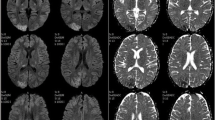Abstract
The purpose of the study was to review the recurrent posterior reversible encephalopathy syndrome (PRES) and emphasize the possibility of repeated attacks on the basis of particular clinical situations. 32 children, diagnosed with PRES were included in our study. The recurrent cases were determined; their radiological features such as involved localizations and clinical information such as presenting symptoms, underlying diseases and clinical prognosis are retrospectively assessed. Of the 32 children (8 months to 18 years old; mean age 11), four of the patients had recurrent episodes of PRES. They had different underlying diseases. One had Chediak–Higashi syndrome, one had ALL, one had chronic renal disease on hemodialysis and one was a renal transplant recipient. Three of the children recovered with no residual neurological deficits, one of them passed away due to multiorgan failure. Three of them had high blood pressures at the time of either one or both PRES, and the renal transplant recipient had also high blood levels of Tacrolimus. Recurrent PRES is encountered most commonly because of repeated increasing blood pressures due to various underlying diseases, immune system disorders or side effects of the treatments.



Similar content being viewed by others
References
Bartynski WS (2008) Posterior reversible encephalopathy syndrome, part 1: fundamental imaging and clinical features. AJNR Am J Neuroradiol 29(6):1036–1042
Donmez FY, Guleryuz P, Agildere M (2014) MRI findings in childhood PRES: what is different than the adults? Clin Neuroradiol. doi:10.1007/s00062-014-0350-2
Bartynski WS (2008) Posterior reversible encephalopathy syndrome, part 2: controversies surrounding pathophysiology of vasogenic edema. AJNR Am J Neuroradiol 29(6):1043–1049
Abe T, Tokuda Y (2014) Recurrent posterior reversible encephalopathy syndrome of the brainstem in a hypertensive patient with end-stage renal disease. J Emerg Trauma Shock 7(3):242–243
Daniel NJ, Hernandez CL, Walker RA (2014) Recurrent posterior reversible encephalopathy syndrome in a pediatric patient with end-stage renal disease. J Emerg Med 46(2):e39–e42
Chang OH, Stanculescu A, Dola C, Rothwell WB (2012) Recurrent posterior reversible encephalopathy syndrome potentially related to AIDS and end-stage renal disease: a case report and review of the literature. Case Rep Med. doi:10.1155/2012/914035
Yamada A, Atsumi M, Tashiro A, Hiraiwa T, Ueda N (2012) Recurrent posterior reversible encephalopathy syndrome in nephrotic syndrome: case report and review of the literature. Clin Nephrol 78(5):406–411
Komur M, Delibas A, Arslankoylu AE, Okuyaz C, Kara E (2012) Recurrent and atypical posterior reversible encephalopathy syndrome in a child with hypertension. Ann Indian Acad Neurol 15(3):208–210
Donmez FY, Basaran C, Kayahan Ulu EM, Yildirim M, Coskun M (2010) MRI features of posterior reversible encephalopathy syndrome in 33 patients. J Neuroimaging 20(1):22–28
Covarrubias DJ, Luetmer PH, Campeau NG (2002) Posterior reversible encephalopathy syndrome: prognostic utility of quantitative diffusion-weighted MR images. AJNR Am J Neuroradiol 23(6):1038–1048
Hugonnet E, Da Ines D, Boby H, Claise B, Petitcolin V, Lannareix V, Garcier JM (2013) Posterior reversible encephalopathy syndrome (PRES): features on CT and MR imaging. Diagn Interv Imaging. 94(1):45–52
McCoy B, King M, Gill D, Twomey E (2011) Childhood posterior reversible encephalopathy syndrome. Eur J Paediatr Neurol 15(2):91–94
Marra A, Vargas M, Striano P, Del Guercio L, Buonanno P, Servillo G (2014) Posterior reversible encephalopathy syndrome: the endothelial hypotheses. Med Hypotheses 82(5):619–622
Vargas M, Servillo G, Striano P (2012) Serum lactate dehydrogenase as early marker of posterior reversible encephalopathy syndrome: keep your eyes open. Anaesth Intensive Care 40(3):570–571
Schwartz RB, Feske SK, Polak JF, DeGirolami U, Iaia A, Beckner KM, Bravo SM, Klufas RA, Chai RY, Repke JT (2000) Preeclampsia-eclampsia: clinical and neuroradiographic correlates and insights into the pathogenesis of hypertensive encephalopathy. Radiology 217(2):371–376
Girişgen I, Tosun A, Sönmez F, Ozsunar Y (2010) Recurrent and atypical posterior reversible encephalopathy syndrome in a child with peritoneal dialysis. Turk J Pediatr 52(4):416–419
Roy S, Gandhi AK, Jana M, Julka PK (2014) Recurrent posterior reversible encephalopathy syndrome after chemotherapy in hematologic malignancy-posterior reversible encephalopathy syndrome can strike twice!!! J Cancer Res Ther 10(2):393–396
Sweany JM, Bartynski WS, Boardman JF (2007) Recurrent posterior reversible encephalopathy syndrome: report of 3 cases–PRES can strike twice! J Comput Assist Tomogr 31(1):148–156
Ergün T, Lakadamyali H, Yilmaz A (2008) Recurrent posterior reversible encephalopathy syndrome in a hypertensive patient with end-stage renal disease. Diagn Interv Radiol 14(4):182–185
Lee VH, Wijdicks EF, Manno EM, Rabinstein AA (2008) Clinical spectrum of reversible posterior leukoencephalopathy syndrome. Arch Neurol 65(2):205–210
Conflict of interest
Dr. Fuldem Yildirim Donmez and Dr. Ahmet Muhtesem Agildere declare that they have no conflict of interest.
Author information
Authors and Affiliations
Corresponding author
Rights and permissions
About this article
Cite this article
Donmez, F.Y., Agildere, A.M. Recurrent childhood PRES. Neurol Sci 36, 1603–1609 (2015). https://doi.org/10.1007/s10072-015-2212-3
Received:
Accepted:
Published:
Issue Date:
DOI: https://doi.org/10.1007/s10072-015-2212-3




